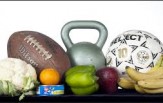Your Most Powerful Tool to Improve Performance…
Athletes and Coaches are always on the lookout for anything that could give them or their Teams an edge. Truly abusive-sounding Training Protocols, insanely high volumes of 'conditioning' or speed work or exotic supplements like Russian Velvet Deer Antler or dried 'Chinese Caterpillar'. The ability to train or play harder, lift more and recover better are certainly paramount and worth the effort, but if you believe that Olympic-level approaches and practices help Olympians become the best in the world, perhaps we should look at what Olympians do.
The International Olympic Committee has put a high priority on Food and Nutrition as far back as 2002. Their Sports Nutrition Consensus Statement reads this way...
"The amount, composition and timing of food intake can profoundly affect sports performance. Good nutrition will help athletes train hard, recover quickly and adapt more effectively with less risk of illness or injury."
They continued "The right diet will help athletes acheive an optimum body size and body composition to acheive greater success in their sport." One my nutrition professors used to say that most athletes just don't understand how amazing they could be if they just took care of their nutrition.
Lets define 'amazing' so we know just whats at stake if we continue to handle our 'fueling' the way we always have...
Beginning with Recovery. When we train, we are trying to 'wreck' our body in a controlled, specific way. If we stress or tear down what we have today, we have made it better for tomorrow. By training, we acknowledge that what we have today is inferior to what we need in the future. Every time we train, we are tearing down what we have to gain something better.
If you're in construction, you know that Building requires Building Materials, more bricks for a bigger building, more concrete for more square footage. With this in mind, for more You- you've got to 'put more into You'. This is the essence of recovery, covering the cost of all your activity with a calculated margin to allow for muscle growth.
As a female athlete, you may say "I don't want to look like a guy/get all muscular"... If thats the case, you need to look at female College athletes, quite muscular, but also quite lean- muscular doesn't mean Big.
Continuing, we must address the athlete's high Energy Expenditure. You would never consider taking a long drive while short on Gasoline, full glycogen stores and plenty of blood sugar for hard practices, winning competition and training sessions require an eye on putting your 'gas gauge' on Full.
You wouldn't try to fill your tank with Gas with the gas cap on, the same way, there is an Optimal time to re-fuel your athletic 'tank' too. While the whole "Low-Carb or No-Carb approach is as widely popular as it is is misguided, poorly timed carbs can be stored as fat and lock down fat release (step one of fat burning).
Training or intense Practice sessions in your sport are what make the difference. Say that you consume 100 grams of carbs without having trained or practiced and 50 grams may go toward glycogen storage and the other 50 will have to be burned as they are available or stored as fat. An efficiency of only 50%.
After training or a long or hard practice, that efficiency can go to 75-90 grams stored as glycogen (to fuel future athletic endeavors) with only 10-25 needing to be burned at the time or be stored as fat. So the practice of Post-Workout refueling across the 3 hours after training is just as important to female athletes as males in their efforts to get stronger while staying lean.
There is more to say on this subject, but I'll let you chew on this for a day and save the rest for dessert...
Athletically yours,
King Hoover- Transforming Athletics







